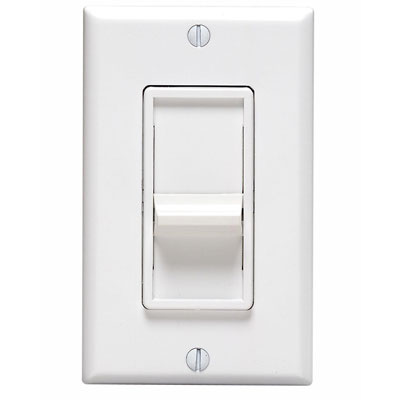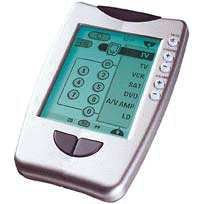Home Theater Lighting
Control: Beyond the Light Switch
In Home Theater Lighting, Lighting, Lighting, the reasons for addressing the issue of lighting were outlined. In this article, the different methods of home theater lighting control will be discussed.
Dimmer Switch
Everyone is familiar with the classic dimmer switch. A dimmer switch can be inexpensive, easy to install, and readily available at your local hardware store. The dimmer switch provides you with the
means to adjust the intensity
of the room's lighting. They come in various styles, from
those that use a rotary dial for intensity adjustment to those that
incorporate a sliding control.
the
means to adjust the intensity
of the room's lighting. They come in various styles, from
those that use a rotary dial for intensity adjustment to those that
incorporate a sliding control.In its most inexpensive form, the dimmer switch is only capable of adjusting light intensity by hand. While not as flashy and technologically advanced as the other forms of home theater lighting control, it does get the job done. At around $10, they are pretty easy on the wallet too. If you are on a budget, this is certainly a viable method of improving your movie viewing experience through lighting control.
As with most things, you can pay more and gain added functionality. The more expensive dimmer switches can have added features such as a fade to off function, LEDs that allow you to easily locate the panel in the dark, as well as an included remote control to allow you to change light settings from practically anywhere in the room.
Central Lighting Control
A central lighting control provides a greater level of command over your home theater lighting than that of dimmer switches. Central lighting control manages the lighting for a room or multiple rooms from a single location. So, rather than adjusting each dimmer switch individually, the central lighting control allows you to fine-tune the various lights simultaneously.These central lighting controls often incorporate many of the features found on the higher-end dimmer switches, including the LEDs for locating the panel at night, a remote control, and the fade
 control. The fade control can be
invaluable in creating the desired atmosphere prior to watching a
movie. Just as the movie begins to play, you can command the
lights to fade out exactly like in the commercial theaters only in the
comfort of your own home.
control. The fade control can be
invaluable in creating the desired atmosphere prior to watching a
movie. Just as the movie begins to play, you can command the
lights to fade out exactly like in the commercial theaters only in the
comfort of your own home.Zoning is another feature found on central lighting controls. A lighting zone is made up of the various lights in an area. With zones, you will be able to control the lighting in specific areas of the room without adjusting each light individually.
Some central lighting controls on the market let you save various "lighting scenes". Lighting scenes are preset lighting levels that will turn different lights on and off as well as dim or brighten them with a touch of a button. These lighting scenes can be tailored in order to create different moods for different activities. This is especially helpful if your home theater is actually your living room. Not only will you be able to create a specific home theater lighting scene, you will also be able to create lighting scenes for all of the other activities that take place in your living room.
Learning Remote Control
Today's remote controls are incredible. The learning remote controls on the market today can replace many of the ones you use for your home theater system by "learning" the necessary protocol or code. This is also the case with the lighting controls for your home theater. If the central lighting control you use includes an infrared remote control, a learning remote control maybe
able to incorporate its code allowing you
to do everything related to your home theater system from anywhere in
the room. Many learning remote controls give you the ability
to program various events with macros.
For example,
you could program a button for "Watch Movie". When activated,
the remote control will turn on the TV, DVD player, receiver and adjust
the lights to your preset movie viewing preference. All of
this would be taken care of by a single button while you are sitting on
the couch.
maybe
able to incorporate its code allowing you
to do everything related to your home theater system from anywhere in
the room. Many learning remote controls give you the ability
to program various events with macros.
For example,
you could program a button for "Watch Movie". When activated,
the remote control will turn on the TV, DVD player, receiver and adjust
the lights to your preset movie viewing preference. All of
this would be taken care of by a single button while you are sitting on
the couch.Choosing a Central Lighting Control unit
The unit you choose will depend on your specific needs. When deciding on a central lighting control unit, ask yourself do you want to control just one room or multiple rooms? Take note of how many scene you can store as well as the number of zones it is able to control. Does it allow you to connect to other units? Connecting more than one unit multiplies the number of zones available on some products. Does it include a remote control? If not, is a remote control available? Does it use infrared (IR) or a radio frequency (RF) to control the unit? While RF will give you the ability to change settings while in another room and through walls, be aware that most learning remote controls use IR and will not be able to control a unit that uses RF.As you can see, the options for home theater lighting control are numerous and the possibilities are limited only by your imagination and your budget. Even if you are not able to afford a central lighting control at this time, definitely go for the dimmer switch. At around $10 a piece there is no reason not to part ways with that antiquated on/off switch.